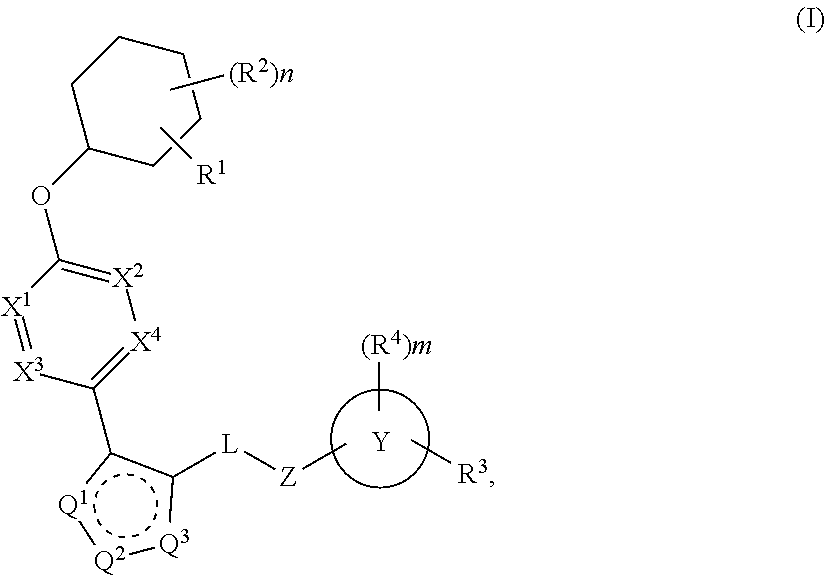Cyclohexyl acid triazole azines as lpa antagonists
a technology of cyclohexyl acid triazole azines and antagonists, which is applied in the field of new substituted triazole compounds, can solve problems such as end-organ failur
- Summary
- Abstract
- Description
- Claims
- Application Information
AI Technical Summary
Benefits of technology
Problems solved by technology
Method used
Image
Examples
example 1
-((6-(5-(((4-(tert-Butyl)pyrimidin-2-yl)amino)methyl)-1-methyl-1H-1,2,3-triazol-4-yl)-2-methylpyridin-3-yl)oxy)cyclohexanecarboxylic acid
[0676]
[0677]To a solution of Intermediate 3 (5 mg, 0.014 mmol) in n-BuOH (0.5 mL) was added 4-(tert-butyl)-2-chloropyrimidine (4 mg, 0.021 mmol) and iPr2NEt (5 μL, 0.028 mmol) at RT. The mixture was heated in a microwave reactor at 180° C. for 90 min, then was cooled to RT. To the reaction mixture was added THE (0.8 mL) / H2O (0.4 mL) / MeOH (0.4 mL) and LiOH.H2O (3 mg, 0.070 mmol), and the mixture was stirred at RT overnight. Volatiles were removed in vacuo and the residue was diluted with H2O (5 mL), and then the mixture was adjusted with 1N aq. HCl to pH ˜5 and extracted with EtOAc (3×5 mL). The combined organic extracts were washed with brine (2 mL), dried (MgSO4) and concentrated in vacuo. The crude product was purified by preparative LC / MS (Column: Waters XBridge C18, 19×200 mm, 5-μm particles; Guard Column: Waters XBridge C18, 19×10 mm, 5-μm par...
example 2
-((2-Methyl-6-(1-methyl-5-(((4-phenylpyridin-2-yl)amino)methyl)-1H-1,2,3-triazol-4-yl)pyridin-3-yl)oxy)cyclohexanecarboxylic acid
[0678]
[0679]To a RT solution of 4-phenylpyridin-2-amine (8 mg, 0.044 mmol) in THE (0.5 mL) was added NaH (2 mg, 0.033 mmol, 60% in mineral oil), and the mixture was stirred at RT for 30 min. Intermediate 1 (10 mg, 0.022 mmol) in THE (0.2 mL) was added and the reaction mixture was stirred at RT for 4 h, after which THE (0.8 mL) / H2O (0.4 mL) / MeOH (0.4 mL) and LiOH.H2O (5 mg, 0.11 mmol) were added and the mixture was stirred overnight at RT. Volatiles were removed in vacuo and the residue was diluted with H2O (5 mL); the mixture was adjusted with 1N aq. HCl to pH ˜5 and extracted with EtOAc (3×5 mL). The combined organic extracts were washed with brine (2 mL), dried (MgSO4), and concentrated in vacuo. The crude product was purified by preparative LC / MS: Column: Waters XBridge C18, 19×200 mm, 5-μm particles; Guard Column: Waters XBridge C18, 19×10 mm, 5-μm par...
example 3
[0685]To the crude reaction product 3B were added THF (0.8 mL) / H2O (0.4 mL) / MeOH (0.4 mL) and LiOH.H2O (3 mg, 0.070 mmol), and the reaction mixture was stirred at RT overnight. Volatiles were removed in vacuo and the residue was diluted with H2O (5 mL); the mixture was adjusted with 1N aq. HCl to pH ˜5 and extracted with EtOAc (3×5 mL). The combined organic extracts were washed with brine (2 mL), dried (MgSO4), and concentrated in vacuo. The crude product was purified by preparative LC / MS (Column: Waters XBridge C18, 19×200 mm, 5-μm particles; Guard Column: Waters XBridge C18, 19×10 mm, 5-μm particles; Mobile Phase A: 5:95 MeCN:H2O with 0.1% TFA; Mobile Phase B: 95:5 MeCN:H2O with 0.1% TFA; Gradient: 50-90% B over 20 min, then a 5-min hold at 100% B; Flow: 20 mL / min) to give the title compound (2.6 mg, 5.0 μmol, 36% yield). LCMS, [M+H]+=501.0. 1H NMR (500 MHz, DMSO-d6) δ 8.60-8.47 (m, 1H), 8.29-8.22 (m, 1H), 8.14-8.03 (m, 1H), 7.83 (d, J=8.2 Hz, 1H), 7.55-7.42 (m, 3H), 7.33 (t, J=7....
PUM
| Property | Measurement | Unit |
|---|---|---|
| Volume | aaaaa | aaaaa |
| Volume | aaaaa | aaaaa |
| Volume | aaaaa | aaaaa |
Abstract
Description
Claims
Application Information
 Login to View More
Login to View More - R&D
- Intellectual Property
- Life Sciences
- Materials
- Tech Scout
- Unparalleled Data Quality
- Higher Quality Content
- 60% Fewer Hallucinations
Browse by: Latest US Patents, China's latest patents, Technical Efficacy Thesaurus, Application Domain, Technology Topic, Popular Technical Reports.
© 2025 PatSnap. All rights reserved.Legal|Privacy policy|Modern Slavery Act Transparency Statement|Sitemap|About US| Contact US: help@patsnap.com



